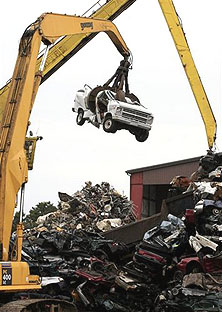 Joe Romm says that although the Cash for Clunkers program was never meant to be a cost-effective way to reduce carbon emissions, in the end it turned out to be very effective indeed:
Joe Romm says that although the Cash for Clunkers program was never meant to be a cost-effective way to reduce carbon emissions, in the end it turned out to be very effective indeed:
In the real world, the public has mostly turned in gas-guzzlers in exchange for fuel-efficient cars — which perhaps should not have been a total surprise since oil prices are rising, gas guzzlers remain a tough resell in the used car market, and most fuel-efficient cars are much cheaper than SUVs. So as a stimulus that saves oil while cutting CO2 for free — it has turned out to be a slam dunk, far better than I had expected.
….Let’s assume the new cars are driven nearly 20% more over the next 5 years [compared to the old cars they replace], and that the average price of gasoline over the next five years is $3.50. Then we’re “only” saving 140 million gallons a year or roughly $500 million a year. The $3 billion program “pays for itself” in oil savings in 6 years. And most of that oil savings is money that would have left the country, so it is a (small) secondary stimulus.
Using a rough estimate of 25 pounds of CO2 per gallon of gas (full lifecycle emissions), then we’re saving over 1.5 million metric tons of CO2 per year — and all of the ancillary urban air pollutants from those clunkers — for free.
I wouldn’t make a habit out of supporting targeted industry programs like C4C, but it was wildly popular, provided a modest but noticeable amount of economic stimulus, and helps reduce U.S. oil consumption. Not bad for $3 billion.

















